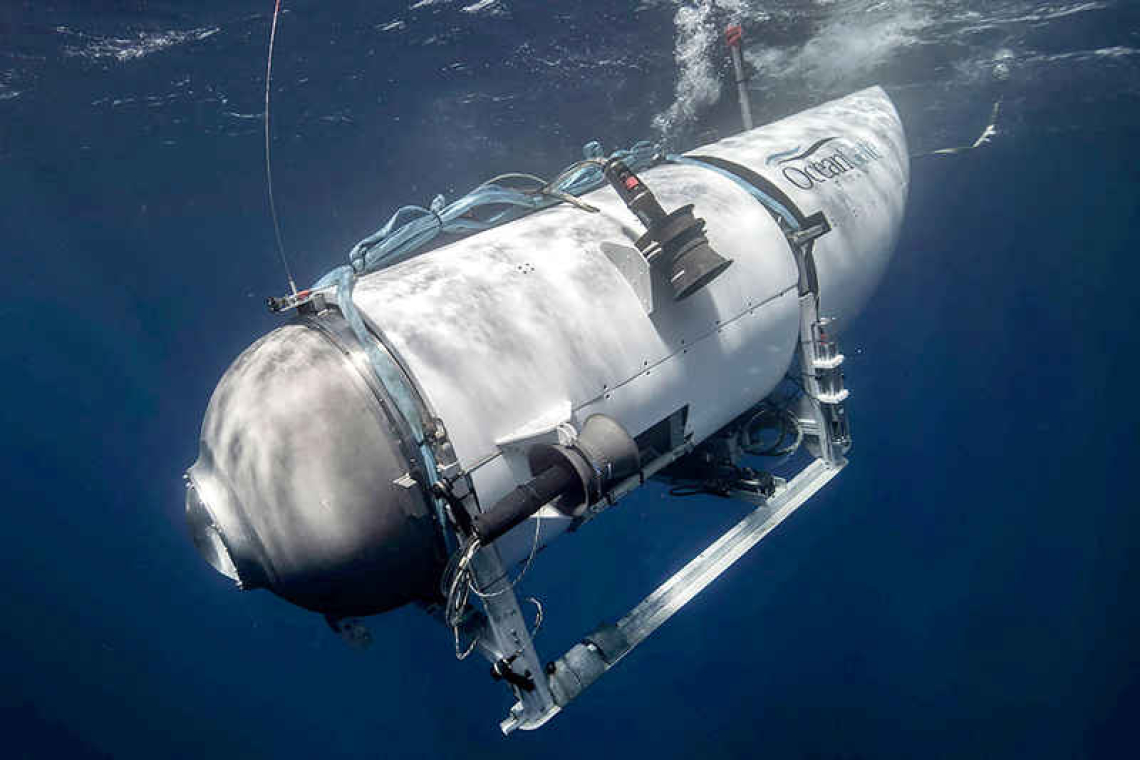WASHINGTON--Rescuers searched a vast swath of the North Atlantic for a third day on Tuesday, racing against time to find a missing tourist submersible that vanished while taking wealthy passengers on a voyage to the wreck of the Titanic in deep waters off Canada's coast. The 21-foot-long Titan was built to stay underwater for 96 hours, according to its specifications - giving the five people aboard until Thursday morning before air runs out. One pilot and four passengers were inside the miniature sub early on Sunday when it lost communication with a parent ship on the surface about an hour and 45 minutes into its two-hour dive. As Canadian and U.S. authorities stepped up the search, previous questions about the safety design and development of the submersible by its owner, U.S.-based OceanGate Expeditions, came to light. The wreck of the Titanic, a British ocean liner that struck an iceberg and sank on its maiden voyage in April 1912, lies about 900 miles (1,450 km) east of Cape Cod, Massachusetts, and 400 miles (644 km) south of St. John's, Newfoundland.
U.S. and Canadian aircraft have searched more than 7,600 square miles of open sea, an area larger than the state of Connecticut, U.S. Coast Guard Captain Jamie Frederick told reporters at a press conference on Tuesday. The Canadian military has dropped sonar buoys to listen for any sounds that might come from the Titan, and a commercial vessel with a remote-controlled deepwater submersible was also searching near the site, Frederick said. Separately, a French research ship carrying its own deep-sea diving robot vessel was dispatched to the search area at the request of the U.S. Navy and was expected to arrive Wednesday night local time, the Ifremer research institute said. Those aboard Titan for a tourist expedition that costs $250,000 per person included British billionaire Hamish Harding, 58, and Pakistani-born businessman Shahzada Dawood, 48, with his 19-year-old son Suleman, who are both British citizens. French explorer Paul-Henri Nargeolet, 77, and Stockton Rush, founder and CEO of OceanGate Expeditions, were also reported to be on board. Authorities have not confirmed the identity of any passenger. Rescuers face significant obstacles both in finding the Titan and in saving the people aboard, according to experts.
If the submersible experienced a mid-dive emergency, the pilot would likely have released weights to float back to the surface, according to Alistair Greig, a marine engineering professor at University College London. But absent communication, locating a van-sized submersible in the vast Atlantic could prove challenging, he said. The submersible is sealed with bolts from the outside, preventing the occupants from escaping without assistance even if it surfaces. If the Titan is on the ocean floor, a rescue effort would be even more challenging due to the extreme conditions more than 2 miles beneath the surface. The Titanic lies 12,500 feet (3,810 meters) underwater, where no sunlight penetrates. Only specialized equipment can reach such depths without being crushed by the massive water pressure. "It's really a bit like being an astronaut going into space," said Tim Matlin, a Titanic expert. "I think if it's on the seabed, there are so few submarines that are capable of going that deep.
And so, therefore, I think it was going to be almost impossible to effect a sub-to-sub rescue." The ability of the tourist sub's hull design to withstand such depths was questioned in a 2018 lawsuit filed by OceanGate's former director of marine operations, David Lochridge, who said he was fired after he raised safety concerns about the vessel. OceanGate said in its breach-of-contract suit against Lochridge, who is not an engineer, that he refused to accept the lead engineer's assurances and accused him of improperly sharing confidential information. The two sides settled their court case in November 2018. The company did not respond to requests for comment from Reuters and its attorney in the Lochridge case, Thomas Gilman, declined comment. An attorney for Lochridge declined comment except to say, "We pray for everyone's safe return." Months prior to the suit, a group of submersible industry leaders wrote to OceanGate warning that the "experimental" approach" to the sub's development could result in "minor to catastrophic" problems, the New York Times reported.







